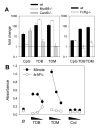Cutting edge: Mincle is essential for recognition and adjuvanticity of the mycobacterial cord factor and its synthetic analog trehalose-dibehenate
- PMID: 20164423
- PMCID: PMC3442336
- DOI: 10.4049/jimmunol.0904013
Cutting edge: Mincle is essential for recognition and adjuvanticity of the mycobacterial cord factor and its synthetic analog trehalose-dibehenate
Abstract
The mycobacterial cord factor trehalose-6,6-dimycolate (TDM) and its synthetic analog trehalose-6,6-dibehenate (TDB) are potent adjuvants for Th1/Th17 vaccination that activate Syk-Card9 signaling in APCs. In this study, we have further investigated the molecular mechanism of innate immune activation by TDM and TDB. The Syk-coupling adapter protein FcRgamma was essential for macrophage activation and Th17 adjuvanticity. The FcRgamma-associated C-type lectin receptor Mincle was expressed in macrophages and upregulated by TDM and TDB. Recombinant Mincle-Fc fusion protein specifically bound to the glycolipids. Genetic ablation of Mincle abolished TDM/TDB-induced macrophage activation and induction of T cell immune responses to a tuberculosis subunit vaccine. Macrophages lacking Mincle or FcRgamma were impaired in the inflammatory response to Mycobacterium bovis bacillus Calmette-Guérin. These results establish that Mincle is a key receptor for the mycobacterial cord factor and controls the Th1/Th17 adjuvanticity of TDM and TDB.
Figures




References
-
- Jo EK, Yang CS, Choi CH, Harding CV. Intracellular signalling cascades regulating innate immune responses to Mycobacteria: branching out from Toll-like receptors. Cell Microbiol. 2007;9:1087–1098. - PubMed
-
- Gross O, Gewies A, Finger K, Schafer M, Sparwasser T, Peschel C, Forster I, Ruland J. Card9 controls a non-TLR signalling pathway for innate anti-fungal immunity. Nature. 2006;442:651–656. - PubMed
-
- Hara H, Ishihara C, Takeuchi A, Imanishi T, Xue L, Morris SW, Inui M, Takai T, Shibuya A, Saijo S, Iwakura Y, Ohno N, Koseki H, Yoshida H, Penninger JM, Saito T. The adaptor protein CARD9 is essential for the activation of myeloid cells through ITAM-associated and Toll-like receptors. Nat Immunol. 2007;8:619–629. - PubMed
-
- Werninghaus K, Babiak A, Gross O, Holscher C, Dietrich H, Agger EM, Mages J, Mocsai A, Schoenen H, Finger K, Nimmerjahn F, Brown GD, Kirschning C, Heit A, Andersen P, Wagner H, Ruland J, Lang R. Adjuvanticity of a synthetic cord factor analogue for subunit Mycobacterium tuberculosis vaccination requires FcRgamma-Syk-Card9-dependent innate immune activation. J Exp Med. 2009;206:89–97. - PMC - PubMed
Publication types
MeSH terms
Substances
Grants and funding
LinkOut - more resources
Full Text Sources
Other Literature Sources
Molecular Biology Databases
Miscellaneous

